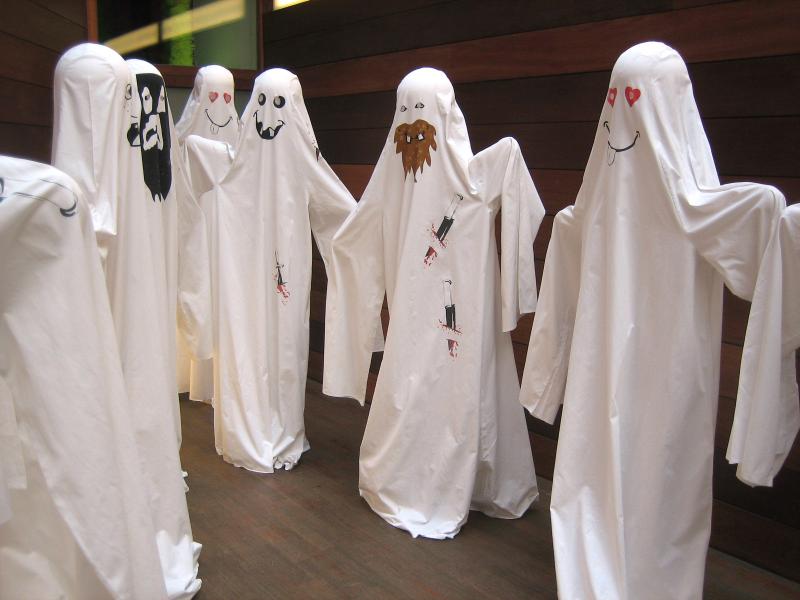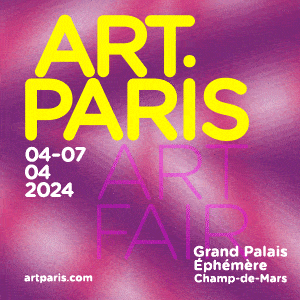Whitehot Magazine
May 2024
"The Best Art In The World"
"The Best Art In The World"
May 2024
December 2007, Bernhard Willhelm, ModeMuseum, Antwerp, Belgium

Bernhard Willhelm, Ghosts 2003, cotton and screenprint
Bernhard Willhelm
by Amy Lin
In 2006, designer Bernhard Willhelm and his partner Jutta Kraus donated their entire collection to the ModeMuseum in Antwerp. For the retrospective exhibition, Bernhard Willhelm: Het Totaal Rappel, Willhelm and Kraus hired Swiss artists Taiyo Onorato and Nico Krebs as art directors to oversee a team of video and audio designers. The result is a series of installations, one for each collection, that reflect the postmodern narratives of Willhelm's work; and yes, the famed Bjork Volta suit is there, too.
The exhibition opens with a parade of sheet ghosts, each wearing a different expression, some with trompe l'oeil screen-prints of bloody knives, winding cheerfully up the staircase to a dark room with more black-lit ghosts hanging from the ceiling and clothing lit so subtly that only the metallic glint of the fabric hints at a silhouette.

Bernhard Willhelm, Black Fall-Winter 2005-2006, velvet, wool, leather and cotton
It's a fitting introduction to Willhelm's take on fashion. The clothes are beautifully made with sensuous combinations of texture and color but its Willhelm's predilection for bizarre fantasy narratives that takes the spotlight. The ghosts were designed for a film by Olaf Breuning involving a man who hallucinates being in a Japanese horror film, a gangster rap, an Amish village and an American Western. He meets a group of French girls and convinces them to take ecstasy pills, only to have them abducted by Willhelm's ghosts. The girls find themselves dressed in Willhelm's 2004 Spring/Summer collection as the ghosts toy with them in a black room. It's crazy but it works.
In another small constructed space, a tiny model train runs around a track where all sorts of small toys are stationed in a riot of colors and positions. The room showcases Willhelm's “Japanese Workers” collection, complete with wide trousers, kimono motifs and the ubiquitous plush animal purse. The clothes blend in with the cacophony, becoming another character.

Bernhard Willhelm, Super the 90s cape collection, Spring-Summer 2006, Cotton and embroidery
“Trashed Room” is an installation of a teenage girl's bedroom houses Willhelm's flannel Mickey Mouse-inspired suits (complete with ears and mittens!), worn by mannequins who slouch amidst the detritus. A video of three models wearing the suits and trashing the room accompanies the installation. It's an observant homage to the modern teenager's thrills of destruction and feelings of invincibility even as they are bound by the materialism of consumer culture.
A generous room houses an installation of kitschy gold tinsel, which hangs from the ceiling, dripping down towards a floor littered with flourescent tube lights. Garbage is heaped to one side and a few mannequins hang out near the bridge in the middle of the room. The clothing almost becomes secondary to the fantastic plastic glitter world. At another installation, the viewer has to peek through holes cut in a fabric sheet to see the clothing embroidered with idyllic landscapes displayed on crude hanging wood torsos against a sky backdrop, complete with cotton clouds. Nearby, a cluster of models wear the “Camouflage Collection” based on televised images of the storming of Saddam Hussein's palace. The camouflage print is made up of innocent kangaroos and frolicking puppies and it should be noted that the show was modeled by male strippers found via the internet who followed an absurd 'indoor survival course' that required knotting balloons and drinking schnapps.
Willhelm's narratives have more in common with Michel Gondry and Wes Anderson than with Christian Dior. He is highly conceptual in his approach, sometimes almost to the point of obliqueness. He crosses, mixes and remixes influences from Superman to the Iraq War to American football players to the language of imagery used by major fashion houses, making his clothing a celebration of postmodernism. His clothes never purport to be trendy, anti-fashion or avant-garde but presents an alternative where clothing is a uniform that reflects the experience of modern culture.

Bernhard Willhelm, Tirolean Room Spring-Summer 2007, cotton, silk, woven fabrics
with embroidery.

Bernhard Willhelm, Untitled (from collection inspired by "Zwarte Woud" attire)
Autumn-Winter 1999-2000, cotton and embroidery
Willhelm is an avid collaborator, working with artists, florists, and designers around the world. Thus the characters in his collections reflect facets of global experiences: media-fueled paranoia, dreams of success and beauty, subcultures and the quest for identity. There is a sense of desperation and mania in his work, further cultivated in his lookbooks and fashion shows. Indeed, we live in crazy times.
Fashion's great crime is its mask of ignorant bliss. The industry is famous for indulging beauty myths and shamelessly schlepping its size-0 glossy imagery, marketing the idea of self-improvement and happiness through consumerism. Where does fashion fit in the contemporary dialog of neo-Imperialism, tech globalism and environmental health? Some designers revel in escapist fantasy, others plunge themselves into an aesthetic exploration of material and form. An admirable group strive to make fashion relevant and critical.
American designer Jeremy Scott's recent “Right to Bear Arms” collection features AK-47-toting Care Bears in a camouflage print. It's cute and ironic in that hipster way and highly consumable. Willhelm's “Camouflage Collection” also pairs innocent imagery with combat uniform but the effect is far more disquieting. Both collections draw from the idea of experiencing the war through television but Willhelm's full-body outfits strongly echo uniforms worn in combat. From far away, the outfits cut an imposing and scary silhouette; the whimsical print is decipherable only up-close. There's an anxiety in viewing the outfits and although it is relieved temporarily upon discovering the cutesy prints, the darker overtones certainly linger.
It is refreshing to see a young, intelligent designer get well-deserved recognition. The exhibition is thoughtfully executed and offers many insights to Willhelm's vision and also the possibilities of fashion as a critical statement. Though his little worlds are immaculately crafted, Willhelm never indulges in escapism – every narrative he makes is visibly tied to the world we inhabit. His clothing wears our hopes, fears and hearts on the sleeve.
Bernhard Willhelm: Het Totaal Rappel is on display at the ModeMuseum in Antwerp, Belgium from July 13, 2007 to January 27, 2008.
ModeMuseum Provincie Antwerpen
Nationalestraat 28, B-2000 Antwerpen
www.momu.be

Amy Lin
Amy Lin grew up in the suburbs of Chicago and spent two years in Beijing. She has a BFA in Painting and a BA in Advertising from the University of Illinois. After a brief stint in Seattle working at an art gallery and as a member of the SHIFT artist collective, she moved to Berlin. She is currently making installation work, starting a tshirt line and learning to play bass guitar. birdhearthoney@gmail.com









